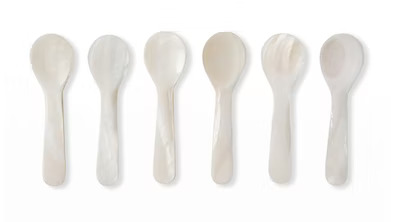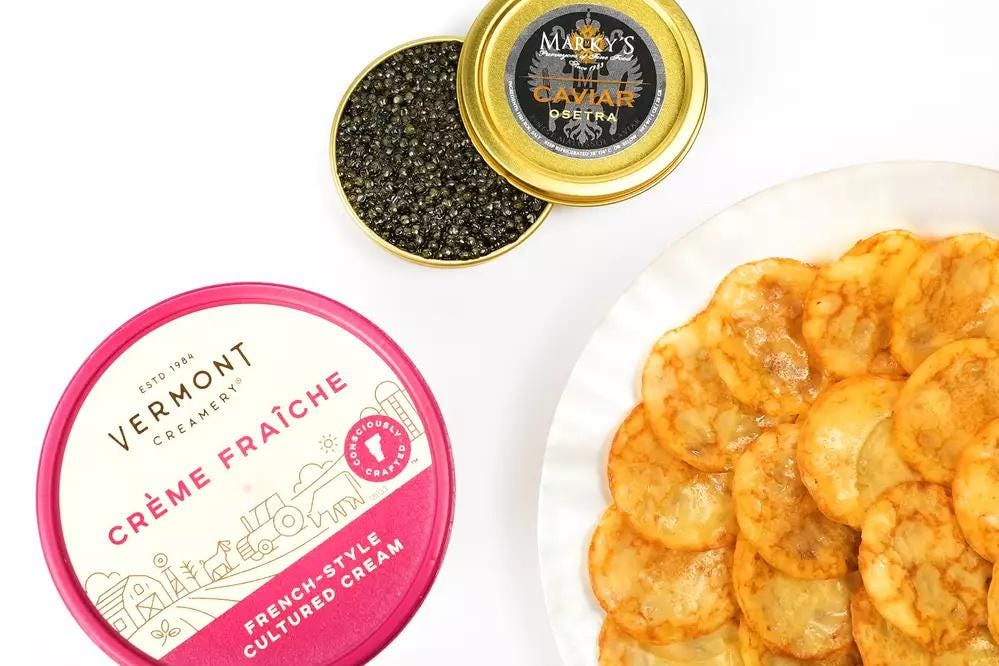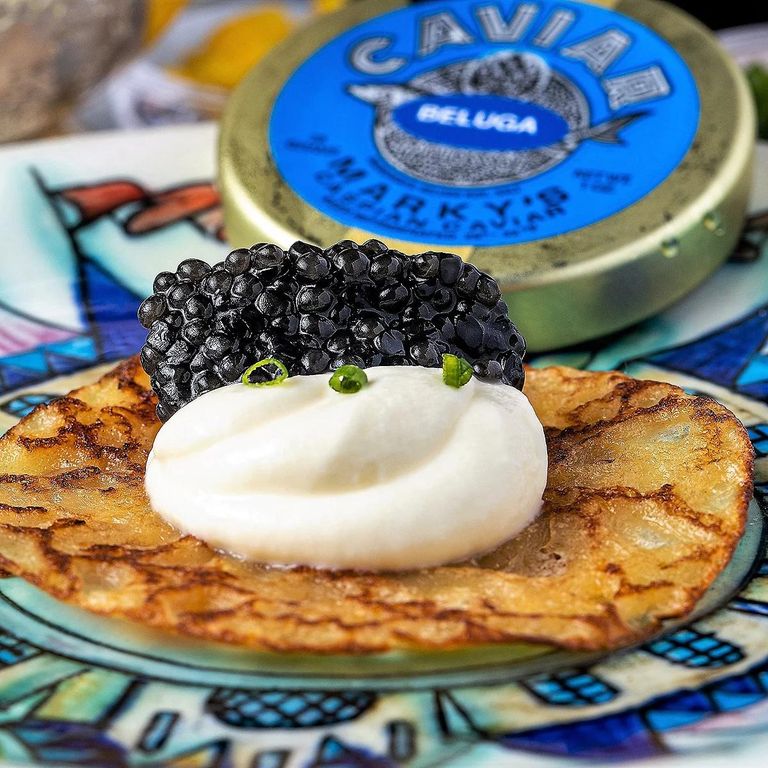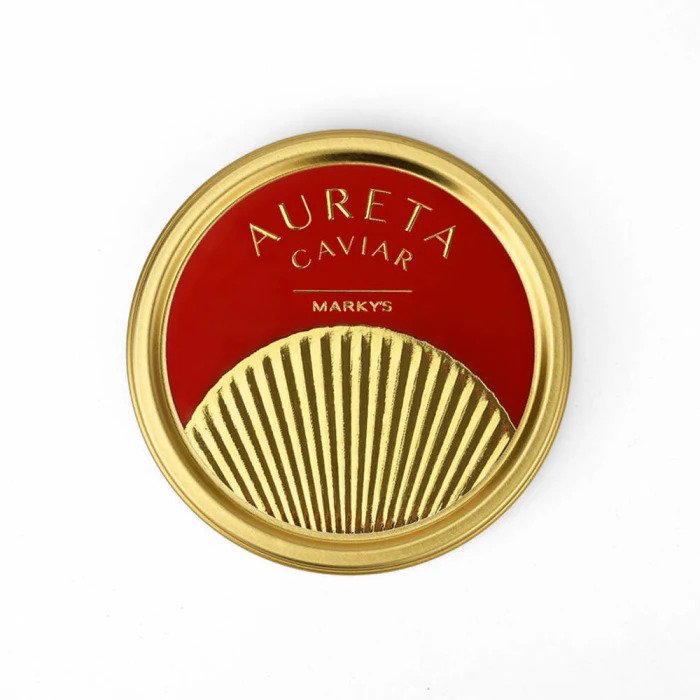A Beginner’s Guide To Caviar
Shopping for caviar online or browsing options in gourmet grocery stores might have never crossed your mind, but if you’re on TikTok you’ve likely become curious about the luxurious food over the last few months. Recently, TikTok users have become more willing to expand their palates, most notably, with caviar — and #caviar has 1.8 billion views on the app to prove it.
It’s clear that the once unapproachable and perhaps even puzzling ingredient has now become a mainstay for many.
This revamped interest in caviar can be credited in part to TikTok user Danielle Matzon (@dzaslavsky). You might recognize her as the reason you just had to try out the Tunacado sandwich from Joe & the Juice — but Matzon’s 534,000 followers are mostly there for her caviar content. Matzon is the vice president of brand partnerships at Marky’s Caviar (story), the family business started by her grandfather Mark Zaslavsky in 1983. She’s been sharing how to enjoy the somewhat elusive treat on her TikTok page ever since garnering a following in the fall of 2022.
“I was introduced to it at a very young age — we would eat black bread with butter topped with caviar,” she tells Bustle. “The reason that I started sharing my love of caviar was to make it more approachable, something you can enjoy on any given day and not only on special occasions.”
In her videos, Matzon shows how to eat caviar alone or in more unorthodox ways — with cream cheese and Doritos, on top of a halved cucumber, on an heirloom tomato that she bites into like an apple. The clips consistently rack up hundreds of thousands of likes. The hashtag #daniellemademedoit has 22.5 million views on TikTok and shows users trying out Matzon’s snack ideas. Still, this might have you thinking: Does everyone know how to buy and enjoy caviar but me? Of course not, but if you want a good place to start, consider this your beginner’s guide to caviar.
What Exactly Is The Difference Between Caviar & Roe?
Fish lovers who may not be familiar with caviar have likely experienced roe before, which is often used as a topping on sushi and comes in orange and reddish hues. While both caviar and roe are fish eggs, caviar must come from sturgeon fish and then be salted and cured. Petra Bergstein, co-founder of The Caviar Co., tells Bustle the difference can be compared to the labeling of sparkling wine. Just as Champagne needs to come from the Champagne region of France, “Same with caviar. In order to be considered caviar, it needs to come from a sturgeon species of fish as opposed to [a different species]... All fish eggs are roe, but not all roe is caviar,” Bergstein says. Traditionally, caviar was harvested from sturgeon species from the Caspian and Black Seas but now can come from over 50 countries worldwide. There are global laws set forth by the Convention on International Trade in Endangered Species of Wild Fauna and Flora and national laws from the U.S. Customs and Borders Protection that regulate where and how caviar can be produced.
What Does Caviar Taste Like?
Since caviar must be cured by definition, every type is oily and salty, almost oceanic, in flavor. There are different factors that affect its taste and mouthfeel. For example, “the warmer the water temperatures, the softer the texture,” says Bergstein. When trying caviar and differentiating its notes, you want to pop the pearls with your tongue up against the roof of your mouth so it reaches all of your taste buds.
While everyone’s taste buds react a little differently, there are plenty of comparisons that can be made when trying out caviar for flavor. For example, when I tried The Caviar Co.’s White Sturgeon, it reminded me of the smell after it rains; meanwhile, Bergstein described it as creamy, buttery, and high in salinity. Siberian Sturgeon, on the other hand, had a heavy umami flavor somewhat comparable to parmesan cheese. The best way to figure out what you like is by tasting several side by side — Bergstein suggests splitting a tasting flight with friends (which can be purchased online or experienced at specialty restaurants) and enjoying it just as you would a wine tasting.
How To Pair & Serve Caviar
If you’ve heard of “caviar bumps” (eating caviar off the back of one’s hand) or seen them on TikTok, you should know it’s not just a trendy way to eat roe. In fact, that’s actually the most traditional way to enjoy the fishy delicacy. “Years and years ago, there used to be so much caviar [readily available] that it was really inexpensive, and you could just buy it at the fish market… So they would open these tins for you at the fish market and slap caviar on the back of your hands, and you would taste it. That's how you'd figure out what you wanted,” Bergstein says.
Caviar should be served with a mother-of-pearl spoon, per tradition. Metal utensils can alter its flavor since it’s so delicate, and wooden utensils, unless specially treated, can soak up the caviar’s oil and change the tasting experience. Of course, nothing is stopping you from scooping the caviar straight from a jar with a Dorito — your secret’s safe with me — but be advised the chip dust might affect the flavor throughout the jar. If hosting a crowd, keep the opened caviar tins on ice and eat them within four days, Bergstein suggests. After day two, the flavor will reach its peak.
Why Is Caviar So Expensive?
Since there are many different types of caviar that come from 27 different types of sturgeon that are typically farmed today, “each type of caviar has a different price range and size options starting from 0.5oz and lots of entry points to choose from,” says Matzon.
While you can shop from specialty sites like Marky’s Caviar or The Caviar Company, chains like Whole Foods and Wegmans carry some species of caviar as well, with some options starting around $40 for a 1-ounce can. Prices go up with the size of the tin and the rarity of the sturgeon species it comes from. For example, “Marky’s is the only company in the USA that is legally allowed to grow, harvest, and sell purebred Beluga Caviar (Huso Huso), which makes this an extremely rare caviar, not only due to its exclusivity but also due to the labor that goes behind it which can take 10 to 15 years before you can harvest it,” Matzon explains — 28 grams of it will cost you $850.
Whether you’re eating from the back of your hand on the daily or pairing it with cheesy chips for a party with friends, there are plenty of ways to dive into the delicacy that can be fun rather than intimidating. Sure, you can always go for a bougie dinner reservation to get your fix, but flexing about your caviar knowledge at home never hurt anyone either. Stay salty, my friends.
Source - Bustle








